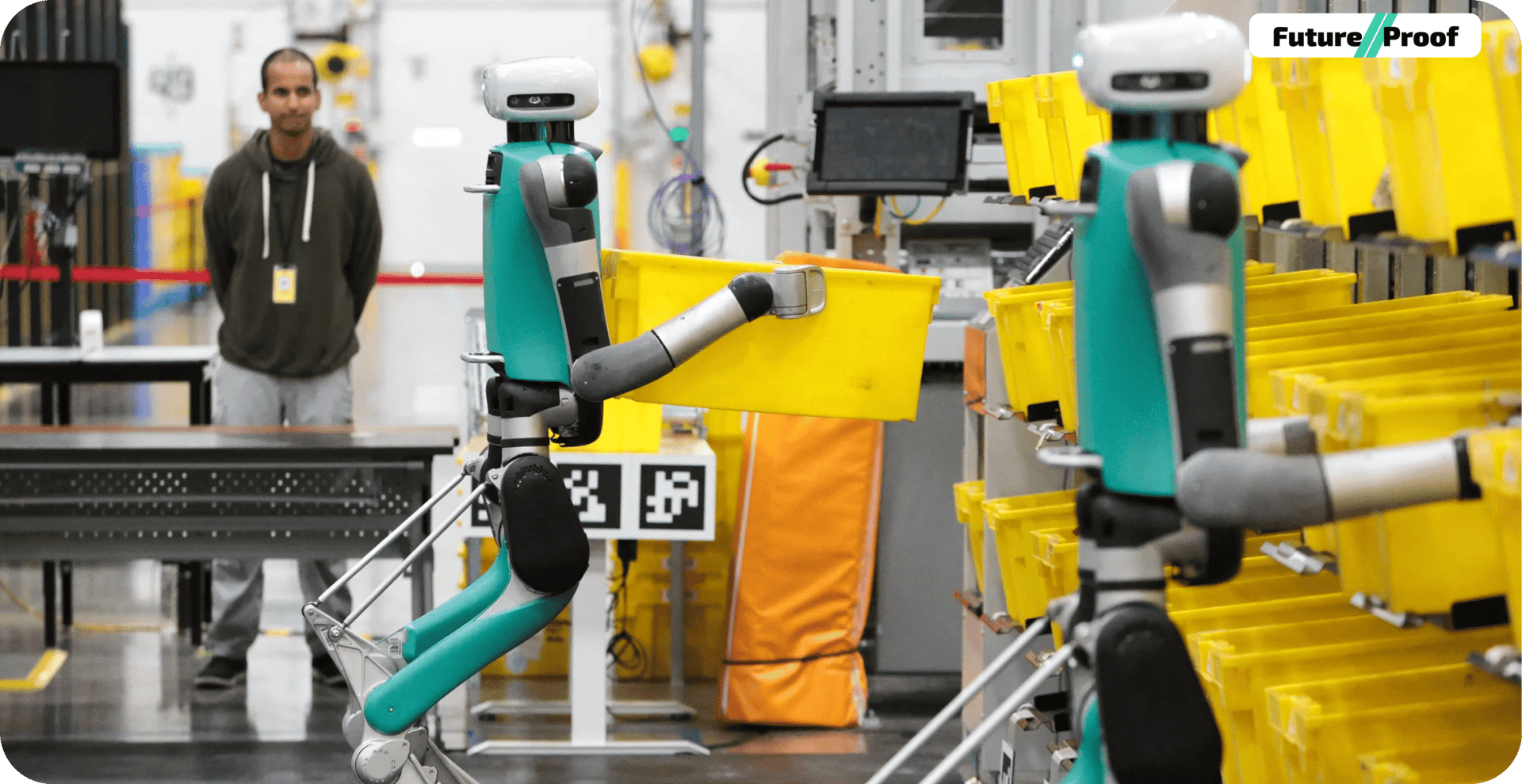- Future//Proof
- Posts
- 🚨 Amazon’s Leaked Docs Expose Plan to Replace 6 Lakh Workers with Robots by 2033
🚨 Amazon’s Leaked Docs Expose Plan to Replace 6 Lakh Workers with Robots by 2033
The inside story of how Amazon plans a robotic future — and what it means for your career 🔥
Welcome to the Future//Proof 🚀
👋 Hello , the AI Enthusiast.
In this week’s edition, we brought AI updates backed by high-quality research and data to give you deeper insights. You'll find the Top AI Breakthrough of the Week, a featured AI tool with a mini-tutorial, learning resources to help you master these tools, the top 3 AI news stories, and more.
Our goal is to help you improve your knowledge and stay ahead in the rapidly evolving AI landscape. You can submit your questions, queries, thoughts, opinions or anything regarding AI as a reply to this email and we'll feature and address them in our next newsletter.
🚀 Now Let’s dive in and explore the new AI Insights together!
⌛ Read Time: 6m:03s
You’re invited to the world’s largest email marketing conference.
Become an email marketing guru at the GURU conference. It’s two days full of all things email marketing. Learn more about newsletters, deliverability, design trends, AI, and what NOT to do with email.
What you can expect:
Keynote Speakers: Nicole Kidman, Amy Porterfield & more!
The latest digital trends in email marketing & how to increase performance.
Networking opportunities - each day!
Dj’s, dance contests (judged by Lance Bass, yes for real), breaking world records & MORE!
Spots are limited. It’s VIRTUAL. It’s FREE. It’s time to become an email marketing GURU. Join 25,000+ marketers on November 6th & 7th. Don’t miss out!
YES! I want to register! (US attendees only!)

An in-depth look at a major AI development, its industry impact, how it could affect your career, and a bold future prediction.

Leaked Documents Reveal Amazon’s Plan to Replace 600,000 Human Roles with Robots by 2033
Amazon is accelerating its robotics deployment strategy, potentially automating up to 600,000 jobs by 2033, according to internal documents reviewed by The New York Times. The company is integrating advanced robots across its warehouses and logistics systems to boost productivity without expanding its 1.5 million-strong workforce. The leaked papers also reveal a calculated communication strategy—replacing “automation” and “AI” with “advanced technology,” and using “cobot” to signal human-machine cooperation. While Amazon publicly denies the claims, it’s simultaneously hiring 250,000 temporary workers for the holiday rush, suggesting a dual-track model: short-term human reliance, long-term robotic transition.
Potential Impact
This shift signals a structural transformation of retail logistics. Expect fully autonomous delivery systems, predictive supply chains, and hybrid “cobot” warehouses where humans oversee machine-led operations. Retailers, logistics firms, and AI robotics startups will benefit from Amazon’s massive data-driven standardization. Warehouses could process orders 40–60% faster, while predictive systems reduce errors and downtime. For competitors, Amazon’s model becomes the new productivity benchmark and a warning sign for labor-heavy operations.
Implications for People/Careers
The automation wave directly threatens low- to mid-skill warehouse, packaging, and delivery roles, an estimated 600,000 by 2033. Entry-level physical jobs will shrink, replaced by demand for robotics maintenance, AI systems monitoring, and logistics analytics. Mid-level managers must upskill toward data interpretation and machine supervision. Meanwhile, senior leadership will need expertise in AI ethics, workforce transition, and algorithmic oversight. The message is clear: humans will no longer do the work—they’ll direct the machines that do.
Our Future//Take
Amazon’s roadmap marks the start of the robotic era in commerce; automation at planetary scale. Within a decade, “manual labor” in logistics may sound as outdated as “dial-up internet.” Those who adapt early—learning robotics operations, data automation, and human-AI collaboration; will lead the next labor economy. Governments, educators, and startups must respond now, shaping re-skilling programs and AI governance before disruption hits full force. The future belongs to those who can build, manage, or interpret machines not those competing against them. Master AI for FREE 🎁

Quick summaries of this week's top AI news, their relevance to your career, and our expert opinions.
Microsoft has launched Agent Mode in Excel and Word, along with a new Office Agent that can draft entire PowerPoint decks and Word documents directly from chat. Agent Mode runs on OpenAI’s GPT-5 and executes multi-step reasoning tasks, scoring 57.2% on SpreadsheetBench compared to a human average of 71.3%—outperforming most competing AI systems. The Office Agent, powered by Anthropic’s Claude models, can structure business reports, summarize data, and generate presentations in real time with built-in web research and live previews. The update is now available to Microsoft 365 Copilot and Microsoft 365 Personal and Family users via the web, with desktop rollout coming soon. This marks the start of Microsoft’s two-engine Copilot strategy: OpenAI for logic-driven planning, Anthropic for high-context writing and synthesis.
Why It Matters to You
This changes how you create, not just how you edit. You can now assign complex workflows—budget planning, quarterly reports, investor decks—to agents that think through steps, fetch data, and produce ready-to-review outputs. For founders, consultants, or analysts, this compresses multi-hour work into minutes. It also raises expectations: clients and managers will start assuming this level of automation is your baseline. Learning to direct and refine these agents will soon matter more than knowing every formula or layout shortcut.
Our Take
Microsoft just redefined Office as an execution engine, not a toolset. Agent Mode turns spreadsheets into living simulations and Word into a thinking collaborator. The dual-model architecture is a quiet but strategic move— hedging reliability, speeding evolution, and positioning Office as the first true “agentic workspace.” The next advantage won’t come from who types faster, but who orchestrates agents better. Start building reusable prompt templates for your recurring reports and decks. Those who systematize their workflows now will own tomorrow’s productivity curve. 👉 Do Not Delay Anymore - Master AI Before Its Too Late.
Zendesk has launched an AI-powered support agent capable of resolving 80% of customer issues without human intervention. The system includes a co-pilot for complex cases, a voice interface, and advanced analytics to handle the remaining 20%. With nearly 20,000 enterprise clients and billions of tickets processed each year, Zendesk is repositioning itself as an AI-first customer service platform. This isn’t just a feature update—it’s a restructuring of the support model itself, where efficiency, speed, and accuracy are driven by automation rather than manpower.
Why It Matters to You
If you run a business or manage customer operations, this changes your economics completely. Scaling customer service no longer requires scaling headcount. You can automate repetitive issues, cut costs, and offer faster responses while focusing your people on the strategic or emotional aspects of service. This is your cue to rethink how much of your customer experience should still rely on humans.
Our Take
Zendesk’s shift sets a new benchmark for AI in business operations. Within a year, “AI-first” support will become the norm, not the exception. Founders and leaders should immediately audit their service workflows and identify tasks that can be automated without losing empathy. The real opportunity lies in combining AI efficiency with human judgment—companies that master that balance will dominate customer trust and retention in the next decade.
A large-scale analysis of 65,000 English-language articles from 2020 to 2025 found that AI-generated pieces now make up around 52% of newly published content—up from about 10% before ChatGPT’s release. Growth peaked in late 2024 and has since flattened. Researchers used Surfer’s AI detector, defining content as AI-written if more than half the text came from a large language model. The detector showed low false positives (4.2%) and near-zero false negatives (0.6%). Yet, human-created content still dominates where attention flows—Google rankings are 86% human, and ChatGPT and Perplexity rely on human-written pages about 80% of the time.
Why It Matters to You
If you publish or build around search and AI, the takeaway is simple: distribution rewards trust, not scale. Flooding the web with AI text doesn’t mean it gets seen. Google, ChatGPT, and other engines still prioritize credibility, original data, and authorship. The winning formula is human insight combined with AI acceleration—authenticity and transparency beat automation at volume.
Our Take
The internet has reached peak AI saturation, and algorithms are pushing back. Expect platforms to double down on human-authored, verifiable content while quietly suppressing generic AI text. The next advantage lies in hybrid models: human-led narratives powered by AI efficiency. Act now—tighten your content strategy, add author signatures, integrate first-party data, and show clear provenance. In this new web economy, credibility is the new SEO. ⚡AI Mastery for FREE (Sign up Now).

Discover a comprehensive guide to an AI tool, exploring its features, practical use cases, and learning resources to help you master it.

Thunderbit is a no-code AI automation platform that lets you build and deploy custom AI agents, workflows, and integrations without writing a single line of code. It connects seamlessly with APIs, databases, and web apps, allowing businesses to automate complex processes using a drag-and-drop visual interface powered by AI reasoning.
⭐ Top Features
No-Code AI Workflows: Design and deploy intelligent automations using an intuitive visual builder.
Custom AI Agents: Create agents that can analyze data, send messages, or trigger actions across systems.
Multi-App Integrations: Connect with popular tools like Slack, Notion, Gmail, or APIs directly for end-to-end automation.
AI-Powered Logic: Combine decision trees with generative AI to handle dynamic, human-like tasks.
Real-Time Collaboration: Build, test, and iterate workflows collaboratively with your team.
Scalable Deployments: Run workflows on the cloud or integrate them directly into your existing products.

A curated list of noteworthy AI tools and their key details to help you stay ahead in your field.

Nexa SDK lets developers run text, image, and voice AI models locally on any device with ONNX and GGML support. It enables privacy-first, low-latency AI apps without relying on cloud APIs.

GitMind uses AI to turn text, files, or audio into mind maps and flowcharts. It’s built for fast brainstorming, team collaboration, and visual project planning.

Shazi VideoGen creates complete videos from scripts using AI for scenes, voices, and editing. Ideal for YouTubers and educators producing faceless or automated content.

Mocko .ai offers AI-powered language exam simulations with instant feedback and adaptive learning paths. Perfect for TEF and TCF test preparation.

A quick poll to help you recollect and engage with key points from the newsletter.
Amazon’s internal roadmap projects what scale and timing for automation? |

Share your feedback on today's edition to help us improve and better meet your needs.
How was Today’s Edition? |
Share our Newsletter ⏩
Enjoying our insights on the latest AI breakthroughs? Don’t keep it to yourself! Share this newsletter with friends and colleagues who are passionate about technology and AI innovation.
If you haven’t subscribed yet, make sure to subscribe here to stay updated with cutting-edge AI news, tools, and tutorials delivered straight to your inbox!
Ask Us Anything AI ❓
Got questions? We've got answers!
Submit your questions, queries, thoughts, opinions or anything regarding AI and we'll feature and address them in our next newsletter. Your curiosity drives our content!
👇 Reply to this email with your questions, and we'll answer them in our next edition!👇

